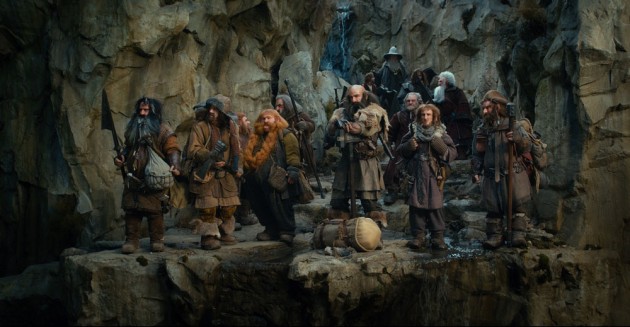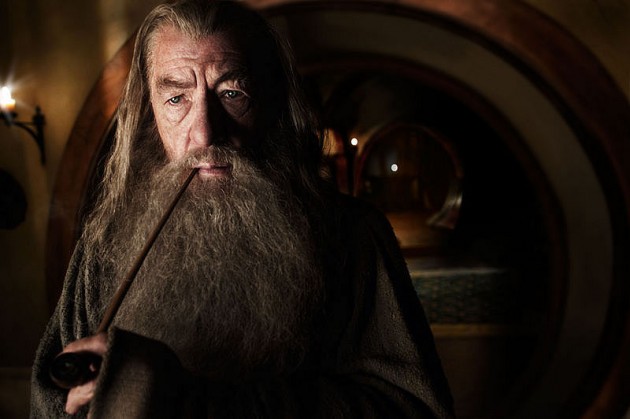
Directed by Peter Jackson
Written by Fran Walsh, Philippa Boyens, Peter Jackson, and Guillermo Del Toro
New Zealand and USA, 2012
Who can blame Peter Jackson for not wanting to leave Middle-Earth? His adaptation of The Lord of the Rings book series, written by J.R.R. Tolkien, was an enormously successful trilogy that culminated in the final film winning a slew of Oscars, including Best Picture and Best Director. If Jackson never made any more movies, he’d still be beloved by fans worldwide for his loving, detailed rendition of a fascinating, all-encompassing universe. Now that he’s behind the camera for a new film based on another Tolkien work set in Middle-Earth, however, it’s hard not to compare The Hobbit: An Unexpected Journey, the first in another trilogy that will end in July of 2014, to the adventures of Frodo Baggins, Aragorn, and the rest of the Fellowship. By itself, An Unexpected Journey is an entertaining, if overlong, fantasy film. Compared to The Lord of the Rings, it falls somewhat short.
Set 60 years before the events of The Lord of the Rings, this first Hobbit film begins as Bilbo Baggins (Martin Freeman, though Ian Holm appears as the older version) finds himself host to a series of strange dwarf guests and an old family friend, Gandalf the Grey (Ian McKellen, of course). This kindly wizard believes the meek and gentle Bilbo is the perfect thief to join the dwarves, led by the taciturn Thorin (Richard Armitage), on a quest to reclaim their home and their riches from a fearsome dragon named Smaug. The adventure is made more difficult as this motley crew encounters goblins, trolls, wolves, and a mysterious little creature named Gollum.

Because it’s a new, big-budget blockbuster, there’s been much hype surrounding The Hobbit: An Unexpected Journey, but none louder than that regarding Jackson’s choice to film the series at a higher frame rate than pretty much every other movie in existence, at a rate of 48 frames per second instead of 24. The effect of watching An Unexpected Journey in both 3D and 48 frames per second (the film is available in 2D and 24-frame-per-second 3D, as well) is, at worst, physically disorienting and, at best, nonexistent. The only point when the imagery seems starkly different than anything that’s come before it is when the characters move quickly, or when action is at a fever pitch; the characters are like wind-up toys, running or walking at unnatural and distracting speeds. Another potential detriment—comparing the 2D, 24-frame-per-second and 3D, 48-frame-per-second images is the only way to know for sure—is that some, though not all, of the special effects look grossly cartoonish. Considering how much money was spent on this series, and how the majority of the film does look real if fantastical, every time the effects appear to be sped up, it’s immensely off-putting.
The rushed feeling also, oddly, applies to a good chunk of the first hour of An Unexpected Journey. Perhaps it’s because Bilbo is joining such a massive group—13 dwarves and Gandalf—but outside of Thorin, Balin (Ken Stott), and Bofur (James Nesbitt), none of the dwarves make an impact. One is outrageously obese, one is young and headstrong, and the others are definitely wearing lots of prosthetic makeup. Unfortunately, these are not the ingredients for even a modicum of character development. Where the Lord of the Rings trilogy gave us nine fully realized humans, elves, dwarves, and Hobbits, An Unexpected Journey gives us a bevy of setpieces populated by two familiar characters and mostly unrecognizable dwarves.

This new film’s unquestioned standout sequence—one that is as good as anything in The Lord of the Rings trilogy, at least—proves the exception to the rule: a lengthy scene where Bilbo encounters Gollum for the first time and has to win a game of riddles to not only stay alive but find a brief bit of salvation. Most, if not all, audiences already know Gollum’s up to no good, so the scene takes on an added level of suspense. And thanks to Andy Serkis, who is once again excellent as Gollum and the best living evidence that performance-capture technology shouldn’t be scrapped permanently, the sequence is tense, dark, and breathtaking. Being honest, most of the setpieces in the film, especially those in the final 45 minutes, are executed quite well. But the difference between those and the face-off Bilbo has with Gollum is that, in the latter, we know and connect to who’s on screen. We’re not just being presented with combat sequences populated with indistinguishable characters.
The cast is, if not always as strong as those in The Lord of the Rings series, always decent. Freeman is a welcome addition to the franchise, capturing the essence of Holm’s fussy nature as the older Bilbo, as well as bringing along a awkward, stammering, straight-man sensibility to his performance. McKellen is his usual powerful self as Gandalf, but the character only has one truly important scene, facing off against Saruman (Christopher Lee), Lord Elrond (Hugo Weaving), and Galadriel (Cate Blanchett) in justifying his plan to help the dwarves return to their rightful home. While Gandalf clarifying his position is important, this feels like an excuse to get the band back together, if only for a few minutes. All four actors seem positively giddy to be back in costume; it’s nice to see them reunited even if the scene is a bit hollow.

The real issue with An Unexpected Journey is its length. Though the movie winds up being shorter than any of The Lord of the Rings movies, not even cresting the three-hour point, it takes a long time to get going. As soon as Bilbo joins the dwarves and Gandalf, leaving his comfortable Shire behind, it’s as if Jackson, and his co-writers Fran Walsh, Philippa Boyens, and Guillermo Del Toro (who was originally going to direct this film), are finally able to put their collective foot on the gas pedal. At just about 170 minutes, An Unexpected Journey seems bloated because the buildup takes too long, and the expansion from Tolkien’s novel—only 310 pages—seems to be applied in strange, unnecessary spots.
The Hobbit: An Unexpected Journey is, at times, a rousing piece of entertainment, an old-fashioned fantasy with brawny fighters, scrappy good guys, and monsters. It is not as immediate in its ability to transport the audience, to whisk us away into Middle-Earth, as The Lord of the Rings films were. An Unexpected Journey is fun, and good enough that the ending tease leaves us wanting a lot more, and fast. But it’s not a great film, a movie that declares itself, as The Fellowship of the Ring did, in no uncertain terms, a sincere and memorably pulse-pounding adventure. Being good may be enough for some devotees, but a tighter, shorter film that wasn’t presented in a wasteful visual flourish would’ve been much closer to achieving greatness.
— Josh Spiegel

